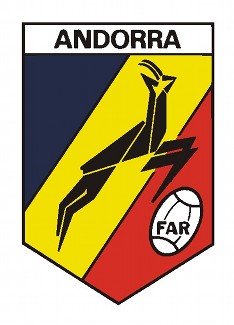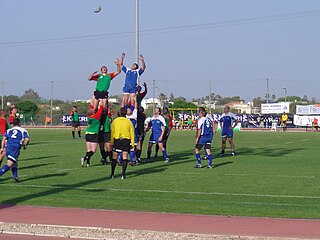Related Research Articles

The Andorra national rugby union team, nicknamed Els Isards represent the Andorran Rugby Federation (FAR) in international rugby union competitions. They play most of their home games in Andorra la Vella, the country's capital, though have had some matches in Foix, which is in France.

The Luxembourg national rugby union team is a minor team, and is ranked as a third tier nation. They are currently competing in the 2024-2025 Rugby Europe Trophy. Since 1996 Luxembourg also competes in the sevens circuits in Europe Luxembourg national rugby sevens team.

Rugby union in Italy is governed by the Italian Rugby Federation. Rugby was introduced into Italy in the early 1900s. It is also known as pallovale or palla ovale within Italy. Two Italian professional teams compete in United Rugby Championship, a league that also includes sides from Ireland, Scotland, South Africa and Wales. One of the teams is guaranteed a place in the European Rugby Champions Cup; the other normally plays in the European Rugby Challenge Cup. The Top12 is the main national club competition. Four Italian clubs from the national championship compete in a qualifying tournament that awards two places in the Challenge Cup. Italy competes in the Six Nations Championship and Rugby World Cup, and is classified as a tier one nation by World Rugby.

The Russia national rugby union team, nicknamed Medvedi, represented Russia in men's international rugby union international competitions. The team is administered by the Rugby Union of Russia (RUR). The RUR is considered the official successor union of the Soviet Union by World Rugby and the combined CIS team which played in the early 1990s. Since 1992, the team has played as Russia. Its first test match as Russia was against the Barbarians in Moscow in June 1992 and the country's first test against an official Test nation was against Belgium later that same year.
Rugby union in France is a popular team sport. Rugby union was first introduced in the early 1870s by British residents, which makes the country one of the few early exponents of the sport. Elite French clubs participate in the professional domestic club league, the Top 14. Clubs also compete in the European knock-out competition, the European Rugby Champions Cup, which replaced the Heineken Cup from 2014 to 2015.

Rugby union in Israel was brought to the country by British soldiers during the British Mandate for Palestine. Rugby Israel was founded as the Israel Rugby Union in 1975, and joined the IRB in 1988. For political reasons it is also part of FIRA-AER, the European rugby body, rather than the Asian Rugby Football Union.
Rugby union in Austria is a minor but growing sport. The national team is currently ranked 79th in the World Rugby's world rankings, which ranks only the top ninety-five countries.

Rugby union in Portugal is a very prevalent sport, though still a long distance from association football. The sport is essentially amateur in Portugal, with some professionalisation in its top flight league and the national rugby union team. The rugby union teams in Portugal are mostly university sides, from Lisbon, Porto and Coimbra, with multi-sport clubs like Benfica and Belenenses having rugby union collectivities.
The Italy women's national rugby union team are the national women's rugby union team that represents Italy at international level. It has been administered by the Italian Rugby Federation since 1991; previously, since its inception in 1985 up to 1991, it was administered by UISP – Unione Italiana Sport Popolari, an association which promotes amateur sports at every level of the society. The team competes in the Rugby World Cup, the Rugby Europe Women's Championship and the Women's Six Nations Championship.
The San Marino national rugby union team represents San Marino in international rugby union. San Marino are a member of the International Rugby Board (IRB) and Rugby Europe.
The Yugoslavia national rugby union team used to represent Yugoslavia at Rugby union until the 1990s.

Rugby union in Poland is a moderately popular sport and currently, the Polish men`s national team are ranked 30th in the world as of 20th November 2022. The Poland women's rugby sevens team won the silver medal at the 2023 European Games behind Great Britain, progressing to the final 2024 Summer Olympic qualification tournament.

Rugby union in Cyprus is a minor but growing sport.

Rugby union in Slovakia is a minor but growing sport.
Rugby union in Slovenia is a minor but growing sport. As of August 2019 they are currently ranked 71st by the World Rugby governing body.

The 2010–12 European Nations Cup is the premier rugby union competition below the Six Nations Championship in Europe.

The 2010 European Under-18 Rugby Union Championship was the seventh annual international rugby union competition for Under 18 national rugby union teams in Europe. The event was organised by rugby's European governing body, the FIRA – Association of European Rugby (FIRA-AER). The competition was contested by 24 men's junior national teams and was held in late March and early April 2010. It was hosted by the Italian region of Veneto, with the final played at the home ground of Benetton Treviso.
The 2011 European Under-18 Rugby Union Championship was the eighth annual international rugby union competition for Under 18 national rugby union teams in Europe. The event was organised by rugby's European governing body, the FIRA – Association of European Rugby (FIRA-AER). The competition was contested by 28 men's junior national teams and will be held in April 2011. It was hosted by the French region of Armagnac and Bigorre. The tournament was won by the under-18 team of Ireland, who took out the title for the first time, beating England in the final. For the first time, France did not reach the championship game and finished in fourth place only.

Rugby Europe is the administrative body for rugby union in Europe. It was formed in 1999 to promote, develop, organise, and administer the game of rugby in Europe under the authority of World Rugby. However, it is not responsible for the organisation of the Six Nations Championship or the competitions run by European Professional Club Rugby.
Polish Rugby Union, abbreviated to PZR, is the only legal Polish representative of Polish rugby union and rugby sevens for both men and women's rugby and all age groups.